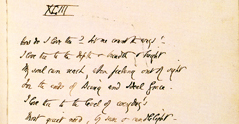NIGHTINGALE, PUBLIC HEALTH AND VICTORIAN SOCIETY
from the British Library, London
Part 1: Correspondence relating to the Crimea, India and Public Health Reform
Lynn McDonald, Consultant Editor
Department of Sociology and Anthropology, University of Guelph
Editor of 'The Collected Works of Florence Nightingale'
Based on the British Library’s superb collection of correspondence and literary manuscripts, this exciting new project enables scholars to explore all aspects of the life and works of a Victorian icon. Part 1 contains material concerning:
- Women in Victorian Society - Florence Nightingale built up a powerful network of contacts including Mary Elizabeth Herbert, Laura Rolfe, Selina Holte Bracebridge, Elizabeth Sutherland, Marianne Strutt Galton and Elizabeth McNeill. All are featured here.
- Public Health Reforms - these were among the proudest achievements of the Victorian Age and Nightingale played an important part in them. We include her correspondence with figures such as
John Sutherland and Edwin Chadwick, with discussions about drinking water and waste disposal, hospital and sanatorium design, the progress of medicine, and the role of women in the medical profession.
- India - she was in touch regularly with successive Viceroys of India and Secretaries of State, prominent reformers, and figures such as Thomas Gillham Hewlett, Health Officer of Bombay and Robert Staunton Ellis, Chief Secretary to the Madras Government.
- The Crimea - it was her actions during the Crimean War that created the public persona of Florence Nightingale. How did the myth match up to reality? We include her correspondence with fellow nurses, military officials and health inspector Robert Rawlinson.
Those researching the history of medicine, nursing, public health and social reform will find her manuscripts to be resource of great value.
|















